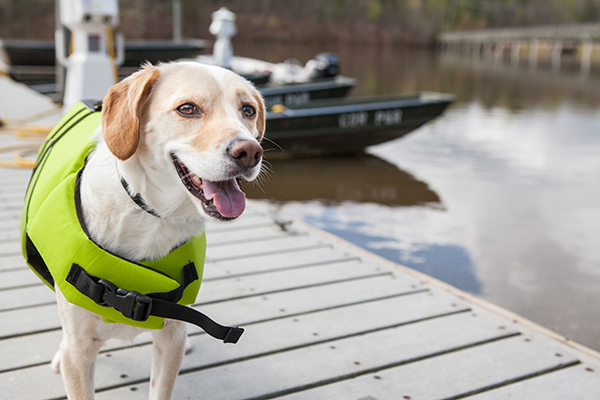With summer here, it's splash season for a lot of dogs and pet parents! For most there's nothing better than cooling down with a dip in the ocean, lake, or backyard pool. No matter where or even if your dog is a natural swimmer, it's important to take water safety seriously. Here's our list of top tips:
- Rule of thumb. Not all dogs are natural swimmers and if you are unsure about your dog, check out their stature. In general, dogs with short legs, large chests, and short muzzles will have a harder time swimming. Take extra precaution with these pups and be sure to follow the safety measures listed here.
- Knows what's up. If you're heading to the beach with your dog or taking them out for a boat ride, make sure things are safe by checking the surf and weather report for dangerous tides and currents. Also, be aware of storm surges and unusually warm water temperatures, which can cause a dangerous jellyfish infestation or blue-green algae growth.
- Never force a dog into water. Even if your dog is a natural water dog, you should still introduce them to water and understand their comfort level. This will ease any anxiety you both may have and will make the experience more enjoyable. If your dog displays any signs of discomfort, don't force them to go in or you will scare them or worse, have an accident and ruin the fun.
- Preserve a life. While the natural water dogs instinctively know how to swim, you'll still want to put them in a life preserver if you're out on a boat or paddle board. If your dog isn't a natural swimmer, it's best to have them wear a life preserver at all times while they're in or around water. In both situations, not only will a life preserver keep your dog afloat but it will also make them easier to spot and gives you something to grab onto if they jump or fall in.
- Sink or swim? It may be obvious but it's important to note that dogs who are heavy on land are way heavier in the water. Therefore, you want to make sure you can handle your dog in water should they jump or fall in.
Pro Tip: If your dog is exposed to a pool try teaching them how to use the steps or a ramp. To do this, get into the water with your dog and teach them to enter and exit the water from that area only. With time and patience, they will recognize this safe area so when they need to get out in a hurry, they won’t tire themselves out or panic because they can’t find a way to get out.
- Don't let them swim too far. Even water dogs will tire quickly because they don't understand the concept of resting or treading water. Some dogs will even keep swimming until they can't anymore so you want to encourage them to take breaks if you plan to be by the water for a long period of time. You also want to make sure that your dog doesn't swim too far away from you so that you can help out if they get into trouble.
- Have fresh drinking water on hand. Don't let your dog drink salt water because it'll cause vomiting or diarrhea, and in extreme cases it could cause salt toxicity. After a swim in the ocean or pool, be sure to rinse your dog off with fresh water to avoid skin irritation. Even with lakes, it's safer to let your dog drink water you bring to avoid the risk of bacteria and parasites. Keep a look out for algae on the water's surface, which can be life-threatening if consumed.

